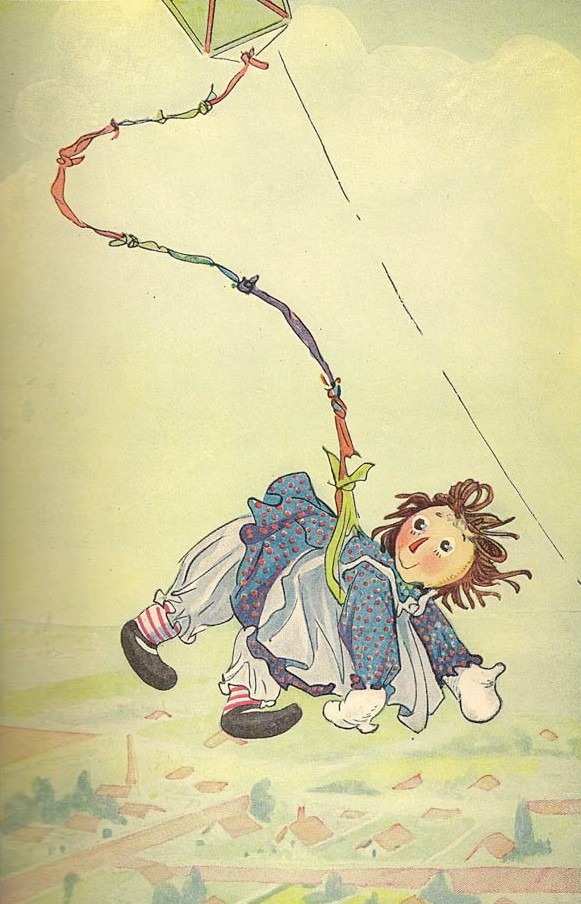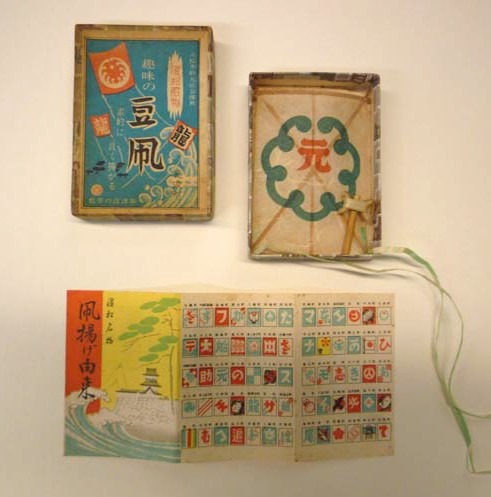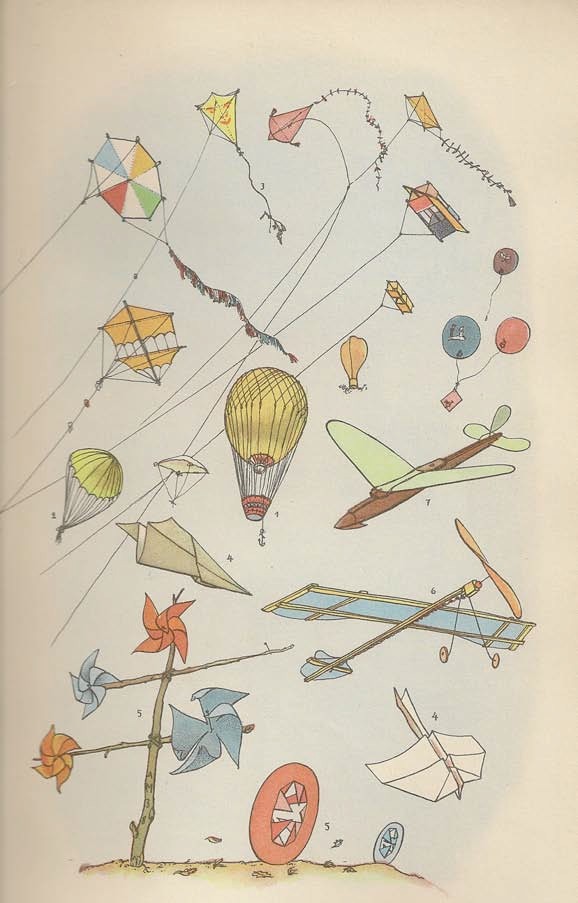KITES: FROM PHYSICS TO FANCY
An interview with Andrea Immel
Visit the online virtual exhibit “Kites: From Physics to Fancy” on the Cotsen Children’s Library website:
http://library.princeton.edu/libraries/cotsen/exhibitions2/Kites/index.html
The exhibit “focuses on the more innocent aspects of the kite’s history as a children’s pastime in Britain and America during the last three hundred years.”

The Cotsen Children’s Library, Department of Rare Books and Special Collections, Princeton University Library. A Beatrix Potter sketch, one of Immel’s favorites. “Only Beatrix Potter could draw animals doing something they would never do in reality, but make them look natural, not saccharine.”
SCOTT SKINNER: ARE THESE IMAGES PART OF THE LIBRARY’S PERMANENT COLLECTION? WHY?
ANDREA IMMEL: All the images in the exhibition come from books in the Cotsen Children’s Library, a unit within the Department of Rare Books and Special Collections at the Princeton University Library. The collection, which consists of over 100,000 historical illustrated children’s books, manuscripts, original artwork, prints, and educational toys, was the gift of Lloyd E. Cotsen, class of 1950 and charter trustee of Princeton University. Mr. Cotsen has always been interested in images of children at play and I keep an eye out for new items to add to the collection.
WERE THEY CHOSEN WITH CONSIDERATION OF ARTIST, OR AS IMAGES OF AMERICANA, OR BOTH? ANY OF THESE ARTISTS “FAMOUS”? ALL OF THEM?
Cotsen’s virtual exhibitions are a way to let people who may never work in Princeton’s rare book reading room see some of the fascinating materials in the collection. One of the ideas is to show people things that will surprise them. I love to hear people say, “Oh, I had no idea there were pictures in children’s books about this,” or “I really like this Czech artist – how come I’ve never heard of him before? What else did he do?” So when researching an exhibition, I try to find as many intriguing images from as many different countries and time periods as possible. Of course, I hope to find terrific pictures by famous illustrators too.
The virtual kite exhibition includes the work of a very important figure in the history of British children’s book illustration. It’s John Bewick, the brother of Thomas Bewick, the great 18th century natural history artist, who invented the technique of wood engraving. (See screen 7, item b in the virtual exhibit at http://library.princeton.edu/libraries/cotsen/exhibitions2/Kites/Kites7b.html.) John was actually better at figure drawing and the invention of subjects than his big brother. Unfortunately, John died in his thirties of tuberculosis, but he produced an impressive body of illustrations for children’s books during his short but extremely busy career. One reason I chose this particular illustration was because of the kite’s unusual decorations. So was John copying something he had seen or was he using his imagination?
DO YOU HAVE A FAVORITE AND WHY DO YOU LIKE IT?
Actually one of my very favorites wasn’t under consideration when I was curating the exhibition! Beatrix Potter made a sketch of four bunnies flying a kite just above the salutation of her March 27, 1895 letter to Noël Moore, the little son of her old governess. (See image on page 15.) But there was already a virtual exhibition devoted to Beatrix Potter and so I reluctantly decided to leave it out.
Why do I like it so much? Only Beatrix Potter could draw animals doing something they would never do in reality, but make them look natural, not saccharine. She probably tossed off this charming little drawing. But it is wonderful how she communicates there is something comical about the idea of rabbits getting a kite up in the air but does this without making fun of them.
ARE THESE IMAGES PART OF A LARGER COLLECTION OF CHILDHOOD-SPECIFIC IMAGES?
They aren’t organized as a collection per se because we’d have to index thousands and thousands of pictures in thousands and thousands of books to make it truly comprehensive. And many interesting images turn up as single illustrations in books that are not about kites or even games and pastimes. Collections of miscellaneous illustrated short texts have been around for a long time, probably because publishers find the format convenient. Authors can be asked to write the stories around existing pictures, for one thing. Our rare book catalogers try to call attention to unusual subjects in the notes, especially in books with generic titles such as The Pretty Picture Book for Good Children. We hope to start developing a visuals database with linked image files in 2011.
WHAT OTHER CHILDHOOD PASTIMES APPEAR IN YOUR COLLECTION THAT MIRROR THESE KITE FLYING IMAGES?
I’ve found that if I look long enough, the collection will yield up images of almost any childhood pastime you can think of, and that includes watching television…
One unusual pastime that turns up occasionally in children’s books is kite riding, for lack of a better term. Kite riders tend to be dolls or small animals like mice, for obvious reasons. As a rule they don’t go very far, but their trips can be pretty exciting.
Perhaps the most famous doll kite rider is Raggedy Ann, who goes aloft as additional ballast in Johnny Gruelle’s Raggedy Ann Stories (Joliet, IL: P. F. Volland, c. 1918). (See page 17, image at left.) And I really like this one from Jessie Pope’s The Adventures of Silversuit illustrated by Angusine Macgregor (London: Blackie and Son Ltd., c. 1910). (See page 17, image at right.) Definitely a “Don’t try this at home” kind of caper.

The Cotsen Children’s Library, Department of Rare Books and Special Collections, Princeton University Library. Raggedy Ann goes aloft in Johnny Gruelle’s Raggedy Ann Stories (Joliet, IL: P. F. Volland, c. 1918).

The Cotsen Children’s Library, Department of Rare Books and Special Collections, Princeton University Library. Image from Jessie Pope’s The Adventures of Silversuit illustrated by Angusine Macgregor (London: Blackie and Son Ltd., c. 1910).
DO YOU CONSIDER THESE IMAGES TO BE LOOKING GLASSES TO THEIR TIMES?
Absolutely. Before curating this exhibition, it didn’t occur to me that kiteflying was traditionally a man’s sport – or was represented as such in children’s books. I didn’t recall girls being excluded from the school athletic field when the wind was up in early spring in Los Angeles and the kites came out.
But I couldn’t even find pictures of girls tagging along behind their brothers and so resigned myself to using the picture from the early nineteenth-century book Nursery Novelties to show how deep the gender divide was. I was literally putting the finishing touches on the show, when the illustration of the tomboy, with her kite slung across her back, popped out of a book I was looking at for another reason. Of course there was no leaving her out. (See screen 4, items a and b in the virtual exhibit at http://library.princeton.edu/libraries/cotsen/exhibitions2/Kites/Kites4.html.)
DO THESE IMAGES REINFORCE THE IMPORTANCE OF “PLAY” IN CHILDHOOD DEVELOPMENT?
Very much so, especially if “play” is defined as leisure with a purpose, where the child is supposed to acquire skills or knowledge outside of the classroom, often by learning how to operate something complex. Two kites are at the center of the wonderful display of educational toys shown in screen 14 of the exhibition. The theory was that boys had to pick up something about scientific principles in order to fly them expertly. I found it interesting that some authors presented the purchase of a kite from a toy store as a kind of cheating. A boy would miss out on the full experience of playing with kites if he didn’t figure out what materials he needed, obtained them at a fair price (or cadged them from a servant), assembled the parts, and made whatever fine adjustments were necessary to keep the kite up in the air.
DO YOU HAVE AN ICONIC KITE IMAGE IN YOUR MIND? WHAT IS IT?
I love the exhibition’s first image – the Adrian van de Venne engraving of the children playing games. The courtyard is teeming with activity and you can almost hear all the noise they must be making. And yet the little boy flying the kite stands out from the crowd. All his attention seems to be focused on keeping his kite aloft, but somehow he has managed not to crash into any of his playmates. The viewer’s eye is drawn up towards the trees, clouds, and sky, where it rests on the graceful, floating figure of the kite. It reminds me of the wonderful sensation of having your feet firmly on the ground, but feeling your spirit soaring as high as your kite.
DOES THE UNITED STATES HAVE AN ICONIC KITE IMAGE?
Benjamin Franklin flying a kite in the electrical storm? It may not be strictly but true, but it has everything – a Founding Father conducting a scientific experiment that leads to a major discovery while to all intents and purposes acting like a kid. But a John Falter cover for the Saturday Evening Post could be another contender.
ARE THERE OTHER KITE IMAGES, EITHER EUROPEAN OR ASIAN, IN THE COLLECTION THAT YOU THINK ARE NOTEWORTHY?

The Cotsen Children’s Library, Department of Rare Books and Special Collections, Princeton University Library. Shumi no mamedako, a set of miniature kites, a souvenir of the annual kite-fighting contest on Boy’s Day in Hamamatsu-shi, Shizuoka-ken.

The Cotsen Children’s Library, Department of Rare Books and Special Collections, Princeton University Library. A taxonomy of toys that catch the wind by Alfred Mahlau in Hans-Friedrich Geist’s Spielzeug (Leipzig: L. Staackmann, 1938).
The beautifully designed taxonomy of toys that catch the wind by Alfred Mahlau in Hans-Friedrich Geist’s Spielzeug (Leipzig: L. Staackmann, 1938) has long been a favorite of mine. (See page 19, image at right.)
One of the reasons this exhibition stayed so close to home (England and America) is because the prospect of trying to mine our enormous collections of Chinese- and Japanese-language children’s books was too daunting! I’m no expert, but I do love Shumi no mamedako, a set of miniature kites that look as if they were part of a big set of collectibles! (See page 19, image at left.) It’s a souvenir of the annual kite-fighting contest on Boy’s Day in Hamamatsu-shi, Shizuoka-ken.
Someone has annotated the box top, identifying the town each kite represents. Maybe one of the readers of Discourse can tell me more about it!

